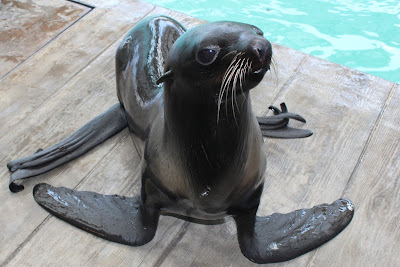Since our Who's Who series about
the fur seals and sea lions was so popular, here's another Who's Who blog, as requested! This time we are going to help you learn how to distinguish the true seals—the harbor seals—apart from one another.
 |
| Atlantic harbor seal (guess who!) |
There are six
Atlantic harbor seals in the exhibit in front of the Aquarium. They are part of
a group of marine mammals called true seals, sometimes referred to as earless seals. Since the male harbor seals are the same size as the females, it makes it a bit harder to tell the two boys apart from the four girls.
First, let's start by identifying the two different families. There is Trumpet, her son Chacoda and daughter Cayenne. All three have very distinctive black spots on their bellies, necks and faces. Be sure not to lump Lana, the only seal not related to anyone in this exhibit, in with these guys; she has more of a dark grey freckled belly. Then, there are brother-and-sister pair, Reggae and Amelia—both have more of a creamier, non-spotted look to their bellies and chests.
Let's break this down a little more:
 |
| Amelia |
Amelia is the only seal with a belly that is totally spot free and cream colored. She has almond-shaped eyes and can be frequently seen taking a nap on the bottom of the exhibit in the shallow end in front of the rocks.
 |
| Reggae |
Her brother,
Reggae, has grey patches on his belly and neck. He is the largest seal in this exhibit and has a square head with large round eyes. You can usually see him bottling (bobbing head-up in the water) in the shallow end of the exhibit and hanging on the pole in the corner.
 |
| Trumpet |
Trumpet has a lighter coat with dispersed black, dash-like spots. She has these marks on her belly, chest, neck and both cheeks. She has narrow, almond-shaped eyes and swims more than rests.
 |
| Cayenne |
Cayenne, compared to the others, is the smallest seal on exhibit. As well as being the most petite, she also has the boldest spots. These black spots are on her belly, chest and neck. She has large black freckles on her cheeks as well. She is most comfortable in the shallow end of the exhibit and will sometimes interact with visitors after hours through the glass.
 |
| Chacoda |
Chacoda (or Chuck, as we call him), has a mottled black/grey/brown belly, chest, neck and face. He also has a square head like Reggae, but isn't as large. He has almond shaped eyes.
 |
| Lana |
Lana used to have a belly that looked more like Reggae's, but just this past molting season, her new coat came in freckled! Lana has a few age related bumps (lovingly referred to as her "old lady lumps") on her sides and hips. Not to worry- they have been checked out by vet staff and are not anything to be concerned about. Lana has a narrow muzzle and is usually swimming around the entire exhibit.
Come test your skills identifying these marine mammals.
Plan a visit to the Aquarium and get to know our endearing plaza ambassadors, the harbor seals.
— Lindsay



















































